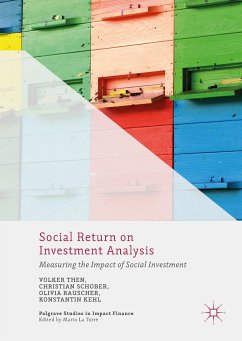This book introduces and explains how to conduct a Social Return on Investment (SROI) analysis. It discusses the various advantages and disadvantages of different research strategies and designs, and explores the different ways in which SROI analysis results can be used for communication, outreach, and strategic decision-making. It provides insights into how and to what extent SROI analyses can help to meet different expectations, and presents different social impact research designs and methods. It presents an analytical framework for the identification of a proper SROI analysis, and shows readers how to establish an impact model, introducing a stakeholder-based approach.
Dieser Download kann aus rechtlichen Gründen nur mit Rechnungsadresse in A, B, BG, CY, CZ, D, DK, EW, E, FIN, F, GR, HR, H, IRL, I, LT, L, LR, M, NL, PL, P, R, S, SLO, SK ausgeliefert werden.
Hinweis: Dieser Artikel kann nur an eine deutsche Lieferadresse ausgeliefert werden.









